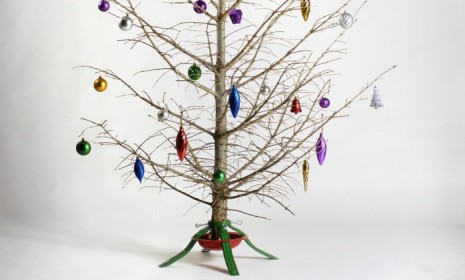Why Christmas trees lose their needles
The science behind all the pine detritus littering your floor and covering presents might surprise you

Like fruitcake and last-minute shopping, the dried-out Christmas tree is a familiar nuisance of the holiday season — a fire hazard that can leave presents draped in a blanket of pine needles. But researchers at Nova Scotia's Christmas Tree Research Center (we kid you not), have been looking into the science behind why Christmas trees shed so quickly, and what can be done about it. Here, a brief guide to their findings:
What makes Christmas trees lose their needles?
A natural gaseous hormone called ethylene signals a tree to shed. Ethylene is produced in response to a variety of factors — environmental, physical, or abuse. It's the same hormone that causes a banana to ripen or leads any fruit or flower to their end. Putting ethylene inhibitors in a tree's water has been shown to prolong its life in scientific experiments, and researchers eventually hope to develop a consumer product that would do the same.
The Week
Escape your echo chamber. Get the facts behind the news, plus analysis from multiple perspectives.

Sign up for The Week's Free Newsletters
From our morning news briefing to a weekly Good News Newsletter, get the best of The Week delivered directly to your inbox.
From our morning news briefing to a weekly Good News Newsletter, get the best of The Week delivered directly to your inbox.
What else can you do keep a tree fresh longer?
Make a new cut on the stump when you first buy it or get it home, at least an inch above the previous cut. Put the tree in water immediately, and maintain the water level. Keep temperatures in your home slightly cooler, if possible, and position the tree away from the kitchen. Also, keep fruits away from the tree as they give off ethylene. Lastly, leave the lights on at night. Being left in the dark causes a tree to respire more, using up its carbohydrates. As a result, says Dr. Raj Lada of the Christmas Tree Research Center, "it can be starved to death."
Does it matter what kind of lights you put on your tree?
As a matter of fact, it does. Researchers tested different spectrums of light — red, white, and blue — and found that trees with white full-spectrum LED lights had the greatest longevity, retaining their needles for an additional 30 or 35 days. "A full extra month," says Lada. Trees with blue lights performed the worst.
A free daily email with the biggest news stories of the day – and the best features from TheWeek.com
Any other Christmas tree science I should be aware of?
Yes! At the University of Cambridge, researchers are conducting experiments to introduce the genes of a harmless glowing bacteria called Euprymna scolopes into other species. If the glowing bacteria could be introduced into trees, "we may soon be putting our presents under a self-illuminating Christmas tree," says Roger Highfield in The Telegraph.
Sources: NPR, The Telegraph, Wichita Eagle
-
 How to financially prepare for divorce
How to financially prepare for divorceThe Explainer Facing ‘irreconcilable differences’ does not have to be financially devastating
-
 Why it’s important to shop around for a mortgage and what to look for
Why it’s important to shop around for a mortgage and what to look forThe Explainer You can save big by comparing different mortgage offers
-
 4 ways to save on rising health care costs
4 ways to save on rising health care costsThe Explainer Health care expenses are part of an overall increase in the cost of living for Americans